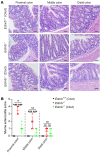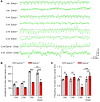Intestinal proinflammatory macrophages induce a phenotypic switch in interstitial cells of Cajal
- PMID: 32809970
- PMCID: PMC7685750
- DOI: 10.1172/JCI126584
Intestinal proinflammatory macrophages induce a phenotypic switch in interstitial cells of Cajal
Abstract
Interstitial cells of Cajal (ICCs) are pacemaker cells in the intestine, and their function can be compromised by loss of C-KIT expression. Macrophage activation has been identified in intestine affected by Hirschsprung disease-associated enterocolitis (HAEC). In this study, we examined proinflammatory macrophage activation and explored the mechanisms by which it downregulates C-KIT expression in ICCs in colon affected by HAEC. We found that macrophage activation and TNF-α production were dramatically increased in the proximal dilated colon of HAEC patients and 3-week-old Ednrb-/- mice. Moreover, ICCs lost their C-KIT+ phenotype in the dilated colon, resulting in damaged pacemaker function and intestinal dysmotility. However, macrophage depletion or TNF-α neutralization led to recovery of ICC phenotype and restored their pacemaker function. In isolated ICCs, TNF-α-mediated phosphorylation of p65 induced overexpression of microRNA-221 (miR-221), resulting in suppression of C-KIT expression and pacemaker currents. We also identified a TNF-α/NF-κB/miR-221 pathway that downregulated C-KIT expression in ICCs in the colon affected by HAEC. These findings suggest the important roles of proinflammatory macrophage activation in a phenotypic switch of ICCs, representing a promising therapeutic target for HAEC.
Keywords: Gastroenterology; Inflammatory bowel disease; Macrophages.
Conflict of interest statement
Figures











Similar articles
-
B-lymphocyte-intrinsic and -extrinsic defects in secretory immunoglobulin A production in the neural crest-conditional deletion of endothelin receptor B model of Hirschsprung-associated enterocolitis.FASEB J. 2019 Jun;33(6):7615-7624. doi: 10.1096/fj.201801913R. Epub 2019 Mar 25. FASEB J. 2019. PMID: 30908942 Free PMC article.
-
Effects of lipopolysaccharide-induced inflammation on the interstitial cells of Cajal.Cell Tissue Res. 2014 Apr;356(1):29-37. doi: 10.1007/s00441-013-1775-7. Epub 2014 Jan 17. Cell Tissue Res. 2014. PMID: 24435644
-
Acetylcholine from tuft cells promotes M2 macrophages polarization in Hirschsprung-associated enterocolitis.Front Immunol. 2025 May 9;16:1559966. doi: 10.3389/fimmu.2025.1559966. eCollection 2025. Front Immunol. 2025. PMID: 40416975 Free PMC article.
-
Interstitial cells of Cajal: clinical relevance in pediatric gastrointestinal motility disorders.Pediatr Surg Int. 2023 Apr 27;39(1):188. doi: 10.1007/s00383-023-05467-1. Pediatr Surg Int. 2023. PMID: 37101012 Free PMC article. Review.
-
Interstitial cells of Cajal in the normal human gut and in Hirschsprung disease.Pediatr Surg Int. 2013 Sep;29(9):889-97. doi: 10.1007/s00383-013-3364-y. Pediatr Surg Int. 2013. PMID: 23917331 Review.
Cited by
-
Interstitial cells of Cajal in gastrointestinal inflammatory diseases.J Smooth Muscle Res. 2023;59:1-13. doi: 10.1540/jsmr.59.1. J Smooth Muscle Res. 2023. PMID: 36792171 Free PMC article. Review.
-
The Trim32-DPEP2 axis is an inflammatory switch in macrophages during intestinal inflammation.Cell Death Differ. 2025 Jul;32(7):1336-1352. doi: 10.1038/s41418-025-01468-w. Epub 2025 Feb 28. Cell Death Differ. 2025. PMID: 40021897 Free PMC article.
-
Neonatal development of intestinal neuroimmune interactions.Trends Neurosci. 2022 Dec;45(12):928-941. doi: 10.1016/j.tins.2022.10.002. Epub 2022 Oct 28. Trends Neurosci. 2022. PMID: 36404456 Free PMC article. Review.
-
Role of Inflammation and the NF-κB Signaling Pathway in Hirschsprung's Disease.Biomolecules. 2024 Aug 12;14(8):992. doi: 10.3390/biom14080992. Biomolecules. 2024. PMID: 39199380 Free PMC article.
-
Neuroimmune Crossroads: The Interplay of the Enteric Nervous System and Intestinal Macrophages in Gut Homeostasis and Disease.Biomolecules. 2024 Sep 2;14(9):1103. doi: 10.3390/biom14091103. Biomolecules. 2024. PMID: 39334870 Free PMC article. Review.
References
Publication types
MeSH terms
Substances
LinkOut - more resources
Full Text Sources
Molecular Biology Databases

